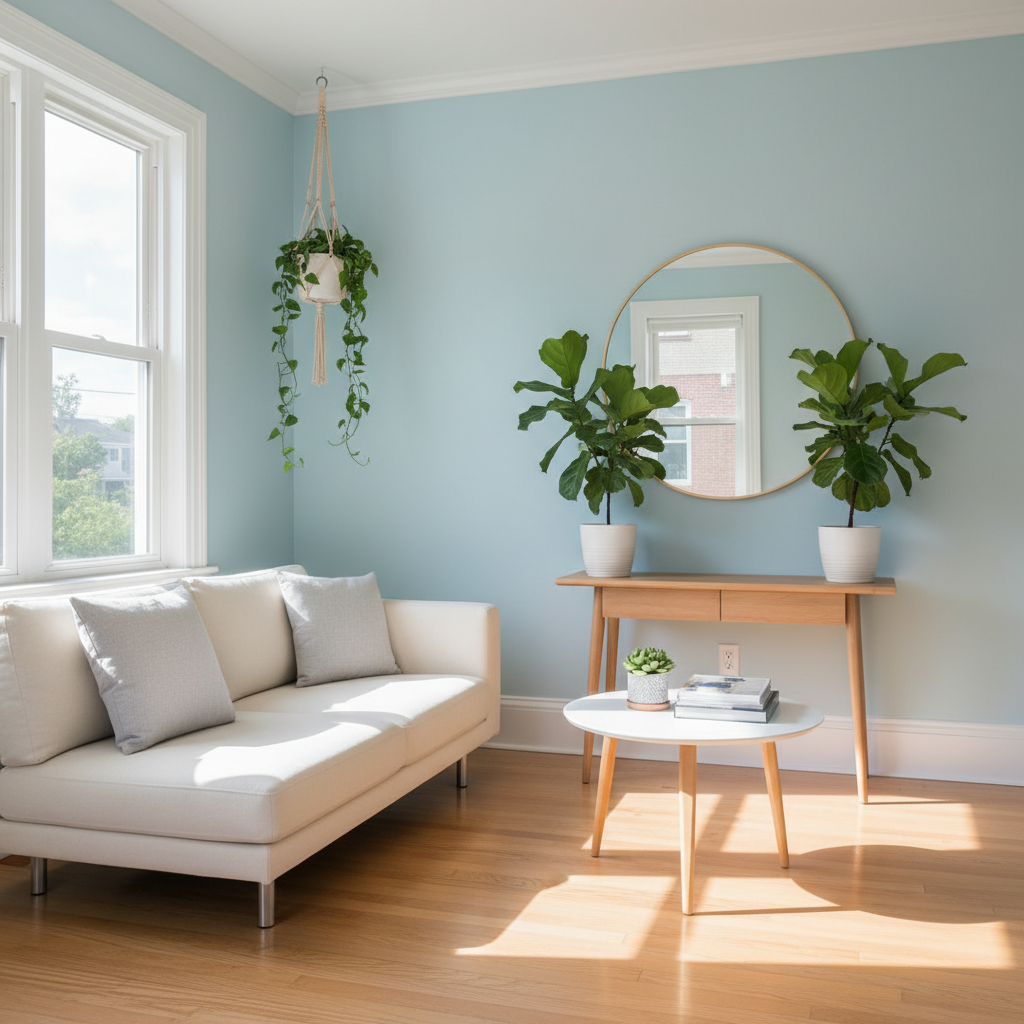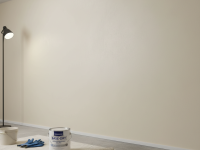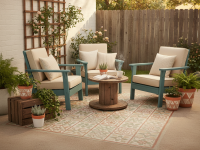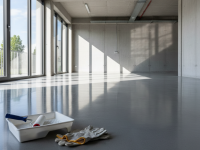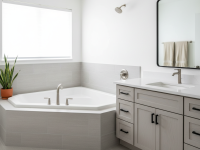Ever Feel Like Your Small Room is Closing In On You?
You know that feeling, right? You walk into a room, and despite all your efforts, it just feels… small. Cramped. Like the walls are giving you a gentle, claustrophobic hug. I’ve been there, trust me. Living in urban apartments for years, I’ve wrestled with tiny living rooms, compact bedrooms, and kitchens that felt more like hallways. But here’s a secret I’ve learned (and seen work wonders): you don’t need to knock down walls to make a room feel bigger. Sometimes, all it takes is a clever coat of paint – or, more accurately, the right *combination* of colors.
It’s not just about picking a pretty shade; it’s about understanding how color interacts with light and tricks our brains into perceiving space differently. As someone who’s spent countless hours experimenting with palettes in my own compact spaces (and offering unsolicited advice to friends with similar dilemmas!), I’m excited to share my go-to strategies. This isn’t just theory; these are techniques that truly make a noticeable difference. So, if you’re ready to ditch the feeling of being boxed in and embrace a more expansive living experience, grab a cup of coffee, and let’s dive into the magical world of wall color combinations.
The Psychology of Space: How Color Tricks Our Eyes
Before we pick up a paintbrush (metaphorically, of course), let’s quickly understand the “why” behind it all. Our eyes are incredibly perceptive, but also wonderfully susceptible to optical illusions. Colors aren’t just pretty; they have specific psychological effects on how we perceive size, distance, and even temperature. Light colors, particularly cool tones, tend to “recede.” Think of a clear blue sky – it feels boundless, right? Darker, warmer colors, on the other hand, tend to “advance,” making walls feel closer than they actually are.
By leveraging this basic principle, we can strategically use color to push walls back, draw the eye upwards, and create an overall sense of opeess and airiness. It’s like giving your room a gentle stretch and a deep breath, all without moving a single piece of furniture. It’s all about creating an illusion of depth and continuity, making the boundaries of the room less defined and therefore, less confining.
My Go-To Palettes for an Expansive Feel
Classic White & Off-Whites: The Ultimate Space Maker
Okay, I know, I know. “White? Groundbreaking!” But hear me out. Pure white isn’t always the answer. A stark, cold white can sometimes feel sterile or even make a small room feel like a hospital waiting room. The trick is to play with off-whites and warmer undertones. Think creamy ivories, soft beiges, or whites with a hint of gray or greige. These colors reflect light beautifully, bouncing it around the room and making it feel brighter and more open.
- Warm Whites: Look for whites with yellow, beige, or even pink undertones. These feel cozy and inviting while still doing the heavy lifting of expanding space. Imagine a delicate “Clotted Cream” or a soft “Chantilly Lace” that brightens without blinding.
- Cool Whites: Whites with gray, blue, or green undertones can create a serene, minimalist vibe. They’re excellent for rooms that get a lot of natural light and you want to enhance that crisp feeling.
I once helped my friend Sarah transform her incredibly tiny studio apartment with a warm off-white, and it was astounding how much larger and more inviting the space felt. It’s not just about brightness; it’s about creating a soft, continuous canvas that lets light play its magic.
Serene Pastels: Soft Hues That Open Up
If white feels too plain for your taste, pastels are your best friends. Light, cool-toned pastels are especially effective because cool colors recede. Think of a pale sky blue, a soft mint green, or a delicate lavender. These colors emulate the feeling of distance and opeess, making walls appear to pull back.
- Pale Sky Blue: This is a classic for a reason. It evokes the feeling of a vast sky or calm water, instantly creating a sense of tranquility and space. It pairs wonderfully with white trim.
- Soft Mint Green: A gentle mint or sage green brings a touch of nature indoors. It’s calming, refreshing, and incredibly effective at making a room feel expansive. It’s less stark than blue but equally effective in its receding properties.
- Delicate Lavender: For those who love a hint of color with a sophisticated twist, a very light lavender can be surprisingly effective. It adds a whisper of color without overwhelming a small space.
The key here is *lightness*. Avoid anything too saturated. The goal is a whisper of color, not a shout. These hues work particularly well in bedrooms or living areas where you want to foster a sense of peace and relaxation while maximizing perceived space.
The Power of Monochromatic: Layering Tones of One Color
This is a designer’s trick that often goes overlooked! Instead of introducing multiple contrasting colors, choose one primary light color and use varying shades and tints of that same color throughout the room. This creates a seamless flow, blurring the lines between different elements and making the space feel more cohesive and therefore, larger.
For example, if you choose a light gray for your walls, you could use a slightly darker gray for your sofa, a lighter gray for your throw pillows, and even a patterned rug with different gray tones. When everything blends harmoniously, your eye doesn’t stop and start at different color changes, allowing the entire room to feel like one continuous, uninterrupted space.
This approach adds sophistication and depth without adding visual clutter. It’s about subtle variations that add interest without fragmenting the space. I’ve seen this done with various shades of light beige and it results in an incredibly chic and expansive feeling room.
Strategic Contrast: Light Walls, Darker Accents
Wait, didn’t I just say light colors make things bigger? Yes! But a *strategic* touch of contrast can actually enhance the illusion of depth. This isn’t about painting half your wall dark; it’s about using darker elements to ground the space and provide definition without closing it in.
- One Accent Wall (Lighter Side): If you want an accent wall, choose a slightly deeper, yet still relatively light, version of your main wall color. For instance, if your walls are a pale blue, a soft powder blue accent wall can add depth without being overwhelming.
- Darker Trim or Baseboards (Carefully): While generally light trim is recommended to make walls appear taller, sometimes a slightly darker baseboard (matching a furniture piece, for example) can ground the room. The key is to keep the walls themselves light and airy.
- Darker Furniture or Artwork: With light walls, strategic placement of a few darker, well-chosen pieces of furniture (like a dark wood console table or a deep-toned armchair) or bold artwork can add visual weight and depth without making the room feel smaller. It provides focal points that draw the eye, creating interest without visual noise.
The trick is balance. Keep the majority of your room light, and use darker elements as thoughtful punctuation marks, not as dominant features. This method adds a layer of sophistication and interest while still respecting the need for an open feel.
Ceiling & Trim Magic: Don’t Forget the Edges!
Walls aren’t the only surfaces that matter. Your ceiling and trim play a huge role in how large a room feels. This is where you can truly leverage continuity.
- Paint the Ceiling the Same as the Walls (or Lighter): This is perhaps one of the most effective tricks. When the ceiling is painted the same light color as the walls, it blurs the line where the wall ends and the ceiling begins. Your eye travels seamlessly upwards, creating the illusion of much greater height. If you must go for contrast, always opt for a ceiling lighter than your walls. A bright white ceiling against light walls will always make a room feel taller.
- Light Trim: Painting your trim (baseboards, door frames, window frames) a bright white or the same color as your walls creates a seamless look that expands the space. Dark trim can “chop up” the walls, making them appear shorter and the room feel more enclosed.
I once painted a tiny bedroom’s walls and ceiling the same light greige, and it honestly felt like the ceiling had lifted by a foot. The room went from “cozy box” to “airy sanctuary” almost instantly.
Beyond Color: Other Elements to Consider
While color is incredibly powerful, it’s part of a larger symphony of design elements. To truly maximize the feeling of space, consider how these complement your chosen wall colors:
- Lighting is Key: Maximize natural light. Keep windows uncluttered. For artificial light, use multiple sources (ambient, task, accent) to brighten corners and eliminate shadows, which can make a room feel smaller.
- Strategic Mirrors: Place large mirrors opposite windows or in dark corners to reflect light and create the illusion of another window or an expanded space.
- Minimalist Furniture & Clutter Control: A small room with too much stuff will always feel small, no matter the wall color. Opt for multi-functional, scaled-down furniture, and be ruthless about decluttering. Less is truly more.
- Vertical Lines: Elements like tall, narrow bookshelves, floor-to-ceiling curtains, or vertically striped wallpaper (on an accent wall) can draw the eye upwards and enhance the illusion of height.
Ready to Embrace the Magic of Color?
Transforming a small room into a perceived haven of spaciousness isn’t about grand architectural changes; it’s about smart design choices, and wall color combinations are at the top of that list. From the soothing continuity of monochromatic palettes to the light-reflecting power of off-whites and serene pastels, you now have a toolbox of proven strategies.
Don’t be afraid to experiment! Grab some paint swatches, tape them to your walls, and observe them at different times of the day. See how the light plays with the colors. Trust your instincts, but lean on these principles, and you’ll be amazed at the transformation. Your small room isn’t a limitation; it’s a canvas waiting for a little color magic. Go ahead, make it feel bigger, brighter, and wonderfully more open!
